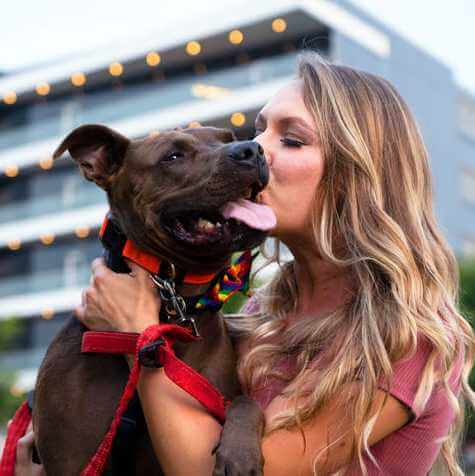
Teaching your dog to sit is one of the easiest commands for your dog to learn. When dogs sit, they settle down in one place and direct their attention towards their owner (you!). Learning to sit on command is also fundamental for learning other commands, such as “LAY DOWN” and “STAY”.
Unlike other commands which teach a dog to disregard their natural instincts (i.e. “HEEL” and “LEAVE IT”), sitting is a natural movement for puppies. With this in mind, you want to make sure that your dog understands the movement of sitting before associating the movement with a command.
Step 1: Learn the Movement
- Find a quiet place to work. An open room inside your house with minimal distractions is ideal for this type of training.
- Hold a treat right near your dog’s nose. Immediately, their attention will shift away from you as they follow the treat in your hand.
- Slowly move your hand up and over your dog’s head. As they raise their nose to follow the treat, their behind will sink lower and lower towards the floor. Eventually, your dog will be in a sitting position. This upward hand movement is the same movement that your dog will learn to associate with sitting.
- When your dog is sitting, release your treat and praise. Make sure that their behind is firmly on the ground, not just hovering over.
Although practice and patience are integral for training, only reinforce Step 1 about 6-12 times. You want to incentivize your dog to follow your hand, but you do not want your dog to become dependent on treats. As a final reminder, the word “sit” should not have been verbalized yet.
Step 2: Generalize the Command
Once your dog understands that they are supposed to sit when your hand moves upward, it’s time to remove the treats from their training (for this command).
- Say the command “SIT” and lure with your empty hand. Keep the hand position and motion the same as when you were holding a treat.
- Praise your dog when they sit on cue. You want your dog to associate the position and movement with the correct behavior. When possible, do not use treats, as you do not want to associate sitting with a food reward.
- Start generalizing the command. Ask your dog to sit in different areas and times of the day. Especially early on in their training, you want to enforce the idea that “SIT” can be given whenever, wherever, and not just in a singular training room. This is a lifelong command, and your dog needs to be able to follow it in every environment.
Step 3: Removing the Hand Motion
Although hand motions are nice and can be easily followed, you want your dog to be responsive to the “SIT” command. If your dog only knows to sit when seeing a visual hand prompt, they will be hard-pressed to follow your instructions if they are not facing you. Once your dog consistently sits upon command, begin practicing using only verbal prompting.
- Remind your dog what it means to “SIT”. Practice a couple of sits with a hand prompt. The upward hand motion will remind your dog that they are supposed to sit when they hear “SIT”.
- Remove the hand prompt and just say “SIT”. Your dog should be anticipating the hand prompt and sit on their own.
- Verbally and physically praise your dog for sitting on cue. Make a big deal out of it. Your dog’s training will be much easier they learn to associate sitting with significant praise.
- If they do not sit after a few seconds, prompt with your hand. Still praise your dog, but only offer a simple reward. The big praise should be reserved for sitting without a visual cue.
Conclusion
Sitting is one of the first commands that your dog should learn. If you can establish this fundamental skill early in their training, you will have a much easier time with more advanced commands and tricks. Always remember that some dogs take longer than others to learn even the most elementary commands, so demonstrate patience and persevere through! Good luck!





